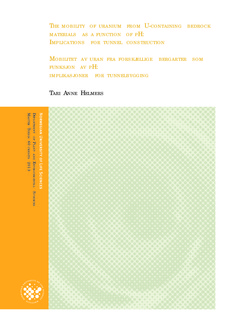The mobility of uranium from U-containing bedrock materials as a function of pH: Implications for tunnel construction
Master thesis

View/
Date
2013-09-10Metadata
Show full item recordCollections
- Master's theses (IPM) [204]
Abstract
According to amendments made to the Norwegian Pollution Control Act in 2011,
naturally occurring radioactive material (NORM) is now to be considered as an
environmental contaminant, in addition to organic pollutants and trace metals. Alum shale areas are rich in radionuclides and, thus, must now be treated as contaminant sources. The substrate media analyzed in this work was collected from a future tunnel construction site that is being built in the Gran municipality on Highway Rv4. The bedrock in the Gran
municipality is rich in U-bearing minerals. Therefore, there is high potential for
environmental contamination from the rock material removed for tunnel construction
purposes.
Environmental contamination is strongly correlated with the mobility and
bioavailability of metals and radionuclides in natural systems. The present work focuses
upon the effects of pH and the contact time (substrate media: solution) on the mobility of
uranium, in aerobic conditions. In order to identify the effects of pH and contact time on
mobility, sample cores collected from an area rich in alum shale were subjected to an
extended leaching experiment. In this experiment, the substrate materials were treated with five different pH solutions (2, 4, 6, 7 & 8) and were analyzed for contact times of two hours, one day, one week and one month. In addition, the results were compared to data from a sequential extraction experiment performed by Halldis Fjermestad (MSc student).
This data was used to characterize the binding mechanisms (speciation) of uranium in
substrate materials of interest. The mineralogical make-up of the substrate material was determined using XRF, XRD and ICP-MS, while the elemental composition of the extracts was determined using ICP-MS.
Of the four sample cores analyzed, two were classified as containing black shale material and two with limestone material. In the leaching experiment, the mobilization of
uranium in all of the substrate material was affected by the pH of solution. All of the
samples were capable of quickly buffering pH solutions with a pH as low as 4 to neutral-alkaline conditions. This was attributed to the carbonate minerals present in all of the
substrate materials studied. However, all of the substrate material had a much lower
buffering capacity for the pH 2 solutions. Therefore, the effects of pH on mobility were
observed in two groupings: media treated with pH 2 solutions and media treated with pH 4-
8 solutions. The black shale materials were particularly sensitive to the pH 2 treatment,
mobilizing 25-36% of the total uranium, compared to the 2-21% mobilization noted in the limestone materials. In contrast, the pH 4-8 treatments resulted in the mobilization of 1-
15% of total uranium for black shale and 0-12% for limestone.
The kinetics of U-mobilization were further described using principal component
analysis (PCA). PCA was performed to illustrate the relationship between U and trace
elements in extracts, and the relationship between mobilized U/trace elements and contacttime.
The mobilization of these elements produced a logarithmic relationship in relation to
contact time, and equilibrium conditions were typically reached around one-month’s
contact time.
Overall, the results of the present work should have strong implications for the
handling of waste materials generated from road / tunnel construction in alum shale areas.